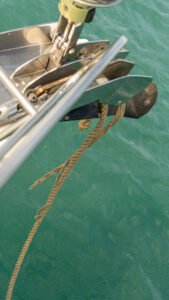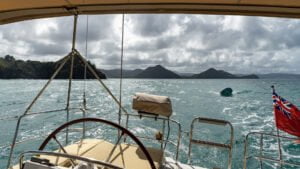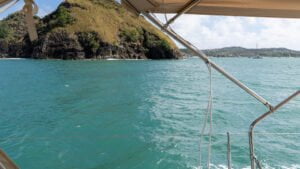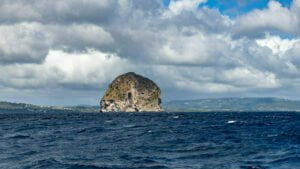Sunrise
Departing St. Lucia today, for points north. I woke up with the sun after a restless night. I think it was the worries associated with the first sail that kept my mind busy and prevented uninterrupted deep sleep. Which is downright unfair, as the winds were calm and there was nary a sound from ashore.
I’m taking a break from getting the boat shipshape by stowing items that could fall. I’ve tied a long line to the dinghy, which I’ll tow behind me. For the 40Km passage I left the engine on, but removed the fuel tank. The engine oil has been checked. So there’s really nothing preventing me from shutting down the computer now at 09:00 and getting under way. Yet I’m procrastinating while I decide whether to just hop into St. Anne or continue up the Martinique coast to anchor overnight in Saint-Pierre.
Morning
It is now 09:15AM and I’ve got the lines ready for setting the mainsail and genoa. All pre-flight inspections are done. I didn’t clean the speed and depth sounder while doing the hull, so I might not have speed but I should have depth. If I go into St. Anne it will be pretty shallow so I’d like to have that instrument working correctly. Speed from the rotor augments the GPS speed, but does go into the autopilot system to allow it to compute the true and relative winds. But the telltales on the sails and the Windex at the masthead do the job just as well.
The instruments are on and the depth looks like it is working correctly. I’ve connected my smartphone to the chart plotter in order to view it from there. I don’t use this, but am just procrastinating – in fact after making the connection I turned off the phone.
The next action is one last check of e-mails before the Starlink RV antenna gets a “stow” command and is stored belowdecks.
Leaving St. Lucia

I started my passage at 10:15 but didn’t actually leave until about 10:30. When I got my anchor up it was fouled with a thick 3-strand dockline which I had to clear away. I was happy that it wasn’t attached to anything on the ground, and stowed it in a garbage bag for later disposal. The worked well for about 10 minutes, then wouldn’t hold any RPMs above 1100 again! It seems that my check after the “hammer mod” was only done with a cold engine. This isn’t good at all, since this gives me only about 2.5 to 3 knots of forward speed when the wind dies. And it always does in the lee of both Martinique and Dominica.
Passage

I got both sails out with about 2 reefs in the main and one int he genoa. This is because Rodney Bay is quite protected and I had no idea of what the conditions were like in the open ocean. I rounded Pigeon Island and discovered that the trades were certainly stronger than the 10-15 that the weather report had given me.

And once clear of land, the waves were 2-2.5m and this was a big problem for me. Not for the boat, but for the poor dinghy I was towing behind me only about 50 feet of line.

The bigger waves coupled with the strong wind would give the dinghy significant “air time” and threaten to blow it over. It was too late to turn around and get the dinghy on deck. All I could do was get a sharp knife and place it next to the cleat holding the dinghy. If it swamped, I’d have to cut it away immediately. A snapped line has a whiplike effect that can be positively deadly.
Martinique

It was exhilarating to sail again. Despite now 2 1/2 reefs in the genoa and 2 in the mainsail there were times I was doing over 10 knots. This made for a fast sail to the southern tip of Martinique and the waves decreased once blocked by the island. I stayed offshore far enough to avoid the dead air zone and the first third of the sail up the coast was a blast. No waves, light breeze, full sails and 6-8 knots of champagne sailing. Then the wind died. I checked offshore to see if I could see where the wind picked up again, but nothing was visible. So on went the engine and I limped forward at 2.5-3.5 knots and barely made it to St. Pierre in the late afternoon.


